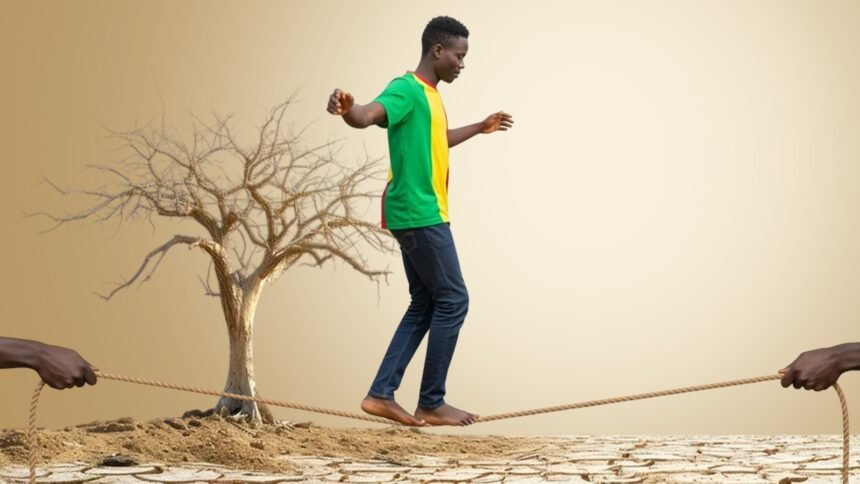Roots in the Sands: Colonial Legacies and the Cycles of Rebellion in Mali
Mali’s narrative of political instability is deeply intertwined with the broader African experience of postcolonial state-building, where colonial boundaries arbitrarily fused diverse ethnic mosaics into fragile national entities. Emerging from French rule in 1960, Mali inherited a centralized bureaucracy ill-suited to its vast, arid expanses and nomadic populations, particularly the Tuareg, whose Berber heritage and pastoral traditions clashed with sedentary governance models imposed from Bamako. Early post-independence leaders like Modibo Keïta envisioned a socialist unity. Yet, economic mismanagement and droughts in the 1970s heightened grievances in the north, where Tuareg clans felt economically sidelined, as their traditional caravan routes were disrupted by modern state priorities favoring the Niger River valley.
The first Tuareg rebellion in 1963-1964 set a precedent for armed dissent, quelled through military force but leaving simmering resentments that resurfaced in the 1990s amid Libya’s spillover from Gaddafi’s support for Saharan separatists. The 1990s National Pact promised decentralization and integration, yet implementation faltered, breeding cynicism. By the early 2000s, a new generation of rebels, hardened by smuggling networks and radical ideologies, reignited conflict, culminating in the 2012 uprising. This event was no isolated spasm but a confluence of global currents: the fallout from Libya’s 2011 collapse flooded the Sahel with weapons, while Mali’s own internal frailties—a corrupt elite, military discontent, and porous borders—created fertile ground for chaos. Jihadist factions like Ansar Dine and AQIM exploited Tuareg nationalism, merging it with transnational Salafism to control Timbuktu’s ancient manuscripts and Gao’s markets, transforming cultural heritage sites into ideological battlegrounds.
In a Pan-African framework, Mali’s rebellions echo continent-wide patterns—from Biafra’s secessionist bids to Somalia’s clan fractures—where peripheral identities challenge monolithic statehood. Climate change exacerbates this, as desertification displaces herders southward, intensifying competition over resources that blur ethnic lines in the face of survival imperatives. Thus, instability in Mali is not merely political but ecological and historical, demanding a reevaluation of federalism that honors Africa’s diverse sovereignties without descending into balkanization.
Beneath the Veil of Power: The Military Ascendancy and Its Perils
The 2020 and 2021 coups, orchestrated by officers disillusioned with civilian ineptitude, initially garnered popular support as a corrective to perceived failures in combating insurgency. Colonel Assimi Goïta’s junta positioned itself as a guardian of Malian dignity, expelling French Barkhane forces in 2022 and embracing Wagner-linked mercenaries—rebranded as Africa Corps—for tactical gains. Yet this shift has entrenched praetorian politics, in which military decrees supplant democratic deliberation, dissolving assemblies and indefinitely postponing elections under the guise of transitional necessity.
Conflicts have metastasized: JNIM’s guerrilla tactics now encompass urban sabotage, from ambushes on convoys to extortion rackets that strangle Bamako’s peripheries, while IS-affiliated katiba target Fulani militias in the center, framing inter-ethnic vendettas as holy war. Dogon-Songhai clashes, once localized, now draw in state-backed janjawid-style proxies, eroding communal bonds forged over centuries. The junta’s rhetoric of sovereignty resonates with a youth weary of foreign meddling. Yet, its heavy-handedness—arbitrary arrests of journalists and opposition figures—foments underground dissent, risking a broader civil rupture.
Pan-African parallels abound: akin to Sudan’s post-Bashir interregnum or Chad’s Déby dynasty, Mali’s militarization highlights the double-edged sword of barracks rule—swift against threats but prone to personalization and exclusion. Economic fallout compounds this; sanctions from ECOWAS, though lifted partially, have spiked inflation, with youth unemployment hovering near 70%, channeling frustration into radical recruitment. Proper stability demands transcending junta-centric security and integrating traditional authorities, such as Tuareg imghad councils, into governance to weave a social contract resilient against ideological tempests.
Threads of Concord: The Intricacies of Mediation in a Fractured Sahel
Mediation in Mali is a delicate art, blending indigenous dispute resolution with continental architectures, yet it is perpetually thwarted by mistrust and asymmetric power. The 2015 Algiers Accord, brokered by Algeria with AU and UN backing, envisioned a confederated north through power-sharing and economic corridors. Still, signatories splintered—Tuareg coalitions like the GATIA clashed with CMA separatists, while jihadists dismissed it as apostasy. Implementation committees languish, hampered by Bamako’s reluctance to devolve fiscal autonomy and rebels’ demands for cultural safeguards.
AU-UN synergies, via the G5 Sahel framework’s remnants, advocate hybrid models: track-one diplomacy in Addis Ababa complemented by local jirgas in Kidal, incorporating marabout mediators whose spiritual authority bridges secular divides. Yet, the junta’s withdrawal from ECOWAS in 2024, alongside Burkina Faso and Niger’s AES pact, fragments regional leverage, prioritizing anti-Western solidarity over punitive isolation. Challenges persist: jihadists’ rejectionism, where negotiations equate to legitimacy, and the opacity of proxy wars, with Russian arms flows muddying attribution.
A forward-looking Pan-African mediation paradigm might emulate Ethiopia’s Tigray talks, emphasizing restorative justice—reparations for drought-hit nomads, joint patrols with community buy-in—to foster ownership. By centering African epistemologies, such as Ubuntu’s relational harmony, Mali could transcend zero-sum pacts and evolve toward a Sahelian confederacy that harmonizes sovereignty with interdependence, countering the isolation that breeds extremism.
Ripples from Afar: Navigating Global Engagements in Mali’s Turmoil
Global actors cast long shadows over Mali, their interventions often refracted through lenses of interest rather than altruism. The U.S., long a counter-terrorism linchpin via AFRICOM’s drone oversight and capacity-building, now treads cautiously, as evidenced by the October 2025 authorization for non-essential evacuations amid escalating threats beyond Bamako. This move signals a recalibration: from robust partnerships pre-coup to measured diplomacy, withholding lethal aid to pressure electoral timelines while contending with accusations of conditional sovereignty.
France’s Operation Barkhane, once a bulwark, yielded to resentment over civilian collateral damage, paving the way for Wagner’s entry with promises of untrammeled support. China, meanwhile, secures phosphate mines and rail links, embodying a non-interfering capitalism that contrasts with Western human rights conditionalities. In Pan-African discourse, these dynamics evoke Nkrumah’s warnings against neo-colonial balkanization, urging a Bandung-style non-alignment in which African states dictate terms, perhaps through AU-led security pacts that pool intelligence without extraterritorial bases.
U.S. efforts, though constrained, persist in humanitarian corridors and women’s empowerment initiatives, aiming to inoculate against radicalization. Yet, efficacy hinges on humility: supporting Malian-led reforms over blueprints, fostering South-South ties like Morocco’s desert expertise to address root volatilities, ensuring external tides bolster rather than buffet endogenous quests for order.
Dawn Over the Horizon: Forging Resilience Amid Mali’s Trials
Mali’s horizon brims with perils yet pulses with potential, its challenges a microcosm of Africa’s adaptive genius. Endemic poverty, with over 40% multidimensional deprivation, intersects with jihadist shadows to spawn child soldiers and refugee flows straining Burkina’s borders, perpetuating a transnational insecurity web. Climate adversities—erratic Sahel rains fueling millet shortages—amplify famine risks, while governance opacity invites elite capture of gold revenues, shortchanging infrastructure.
Pathways forward demand bold reinvention: electoral roadmaps inclusive of diaspora voices, agrarian reforms empowering women’s cooperatives in the Delta, and digital innovations for transparent resource allocation. Pan-African solidarity could catalyze this—leveraging AfCFTA corridors to integrate northern oases into continental trade and diminish smuggling’s allure. Mediations must evolve, incorporating youth assemblies and ecological pacts to preempt conflicts, transforming Mali from a poster child of fragility to an exemplar of resilience.
Ultimately, Mali’s labyrinth invites a profound reflection: instability as Africa’s forge, tempering sovereignty through trials. By honoring its griot traditions of narrative reconciliation, the nation—and the continent—may yet orchestrate a symphony of stability, where desert winds carry not strife but seeds of a unified tomorrow.










